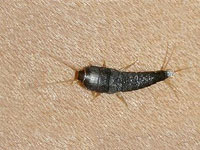Silverfish |
 According to the scientists who study these things, silverfish have never been the cause of any plague or epidemic. No evidence has been found that they transmit diseases to people. Though silverfish will visit and consume many foods that are not stored in insect-proof containers, the bacteria they harbor has not been found harmful to humans. The waste they leave behind is not toxic. This does not mean that anyone would want them in their home. Quite the reverse. The truth is that silverfish are disturbingly ugly, more so than most insects. They are so alien in their appearance that they have inspired many a nightmare as well as monsters in movies and fiction. They have thin, pale bodies, feathery legs, and darting, sinuous movements that make them disappear in a flash before they can be captured or killed. They are common in many houses but, being nocturnal creatures, people rarely see them. When they do discover a silverfish it is always an unpleasant surprise for both the insect and the person. While silverfish do not bring disease to a home, they do cause damage to the home's contents. They live off a diet that is rich in starch and simple sugars. They will consume anything that contains these ingredients. This does not only include unprotected food like flour or cereals and silverfish will do more than raid an uncovered sugar bowl. Paper, adhesives, string, photographs, carpets, and clothing all contain nutrients that silverfish crave. They also eat dead insects, their own molted skins, and the dead bits that people shed, most commonly dandruff, but also hair. Books, since they are made of paper, bindings, and glue are where silverfish cause the most household damage. While having them consume an entire volume is rare, they can nibble away at the cover and pages for years. They also can cause holes in clothing, drapery, and rugs depending on their construction. If they do not find enough appropriate food, they will consume synthetic fibers. An adult silverfish can reach up to an inch in length. They become more grayish with a metallic sheen as they age. They live in cracks and tight spaces where they are difficult to find. They prefer moist areas such as basements, garages, and bathrooms. The bathroom is a particular place where many people are startled by silverfish when they turn on the light at night. The insect will scamper away as soon as the light goes on, retreating to a nearby cranny to elude capture. They are quick, moving like their namesake, and the surprise they cause in people who are half awake is their best defense. Their natural predators are other common household pests: spiders and earwigs. Silverfish are found throughout the world. Their natural range includes more humid climates but they are equally happy to live indoors where the temperature is constant and accommodating year round and the relative humidity is over 75%. This is why they prefer dark rooms with pipes or damp nooks. |
FREE QUOTE
Let's Get Started...
Save 20% By Scheduling Online...
Address
 Website Powered by BannerOS. Your Business Energized!
Website Powered by BannerOS. Your Business Energized!





